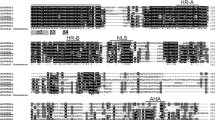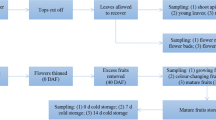Abstract
We used polymerase chain reaction (PCR) to clone the Carica papaya heat stress transcription factor gene, Cphsf. Phylogenetic analysis showed that Cphsf protein, named CphsfB1, is a homolog of Lycopersicon peruvianum HsfB1. Northern blot analysis revealed that CphsfB1 is constitutively expressed in radicles and is heat-inducible in leaves. The blast program embedded CphsfB1 in a gene cluster constituting four genes: accelerated cell death protein 2, abscisic acid 8′-hydroxylase, caltractin, and ethylene-responsive transcription factor. These results suggest that CphsfB1 has diverse roles in radicles and leaves, and may be related to seed germination. Polymorphic nucleotides in the 5′ untranslated region of CphsfB1 were observed from a breeding material of TM1, but not in the cultivar ‘Fruit tower’. Southern blot analysis showed two bands, 2.0 kbp (CphsfB1-2.0) and 2.3 kbp (CphsfB1-2.3), in TM1 and a single band, CphsfB1-2.3, in cv. ‘Fruit tower’. The segregation ratio of CphsfB1-2.0 and CphsfB1-2.3 in F1 progeny derived from a cross between TM1 and cv. ‘Fruit tower’ fitted the expected Mendelian ratio of 1:1 (homozygote of CphsfB1-2.3:heterozygote). From the anther culture of TM1, six homozygotes each of CphsfB1-2.0 and CphsfB1-2.3 were produced. These results suggest that CphsfB1 is a single-locus gene, and CphsfB1-2.0 and CphsfB1-2.3 are alleles.







Similar content being viewed by others
Abbreviations
- hsf:
-
Heat stress transcription factor gene
- Hsf:
-
Heat stress transcription factor protein
- 5′-UTR:
-
5′ untranslated region
- 3′ RACE:
-
Rapid amplification of 3′ cDNA ends
- ABA:
-
Abscisic acid
- CaM:
-
Calmodulin
- CPPU:
-
N-(2-chloro-4-pyridyl)-N′-phenylurea
- NAA:
-
α-naphthaleneacetic acid
References
Bewley JD (1997) Seed germination and dormancy. Plant Cell 9:1055–1066
Bharti K, von Koskull-Döring P, Bharti S, Kumar P, Tintschl-Körbitzer A, Treuter E, Nover L (2004) Tomato heat stress transcription factor HsfB1 represents a novel type of general transcription coactivator with a histone-like motif interacting with the plant CREB binding protein ortholog HAC1. Plant Cell 16:1521–1535
Busch W, Wunderlich M, Schöffl F (2005) Identification of novel heat shock factor-dependent genes and biochemical pathways in Arabidopsis thaliana. Plant J 41:1–14
Finch-Savage WE, Leubner-Metzger G (2006) Seed dormancy and the control of germination. New Phytol 171:501–523
Frohman MA, Dush MK, Martin GR (1988) Rapid production of full-length cDNAs from rare transcripts: amplification using a single gene-specific oligonucleotide primer. Proc Natl Acad Sci USA 85:8998–9002
Gunawardena AHLAN, Pearce DM, Jackson MB, Hawes CR, Evans DE (2001) Characterisation of programmed cell death during aerenchyma formation induced by ethylene or hypoxia in roots of maize (Zea mays L.). Planta 212:205–214
He CJ, Morgan PW, Drew MC (1996) Transduction of an ethylene signal is required for cell death and lysis in the root cortex of maize during aerenchyma formation induced by hypoxia. Plant Physiol 112:463–472
Kumar M, Busch W, Birke H, Kemmerling B, Nürnberger T, Schöffl F (2009) Heat shock factors HsfB1 and HsfB2b are involved in the regulation of Pdf1.2 expression and pathogen resistance in Arabidopsis. Mol Plant 1:152–165
Liu Z, Moore PH, Ma H, Ackerman CM, Ragiba M, Yu Q, Pearl HM, Kim MS, Charlton JW, Stiles JI, Zee FT, Paterson AH, Ming R (2004) A primitive Y chromosome in papaya marks incipient sex chromosome evolution. Nature 427:348–352
Lohmann C, Eggers-Schumacher G, Wunderlich M, Schöffl F (2004) Two different heat shock transcription factors regulate immediate early expression of stress genes in Arabidopsis. Mol Genet Genomics 271:11–21
Ming R, Hou S, Feng Y, Yu Q, Dionne-Laporte A, Saw JH, Senin P, Wang W, Ly BV, Lewis KLT, Salzberg SL, Feng L, Jones MR, Skelton RL, Murray JE, Chen C, Qian W, Shen J, Du P, Eustice M, Tong E, Tang H, Lyons E, Paull RE, Michael TP, Wall K, Rice DW, Albert H, Wang ML, Zhu YJ, Schatz M, Nagarajan N, Acob RA, Guan P, Blas A, Wai CM, Ackerman CM, Ren Y, Liu C, Wang J, Wang J, Na JK, Shakirov EV, Haas B, Thimmapuram J, Nelson D, Wang X, Bowers JE, Gschwend AR, Delcher AL, Singh R, Suzuki JY, Tripathi S, Neupane K, Wei H, Irikura B, Paidi M, Jiang N, Zhang W, Presting G, Windsor A, Navajas-Pérez R, Torres MJ, Feltus FA, Porter B, Li Y, Burroughs AM, Luo MC, Liu L, Christopher DA, Mount SM, Moore PH, Sugimura T, Jiang J, Schuler MA, Friedman V, Mitchell-Olds T, Shippen DE, dePamphilis CW, Palmer JD, Freeling M, Paterson AH, Gonsalves D, Wang L, Alam M (2008) The draft genome of the transgenic tropical fruit tree papaya (Carica papaya Linnaeus). Nature 452:991–996
Mishra SK, Tripp J, Winkelhaus S, Tschiersch B, Theres K, Nover L, Scharf KD (2002) In the complex family of heat stress transcription factors, HsfA1 has a unique role as master regulator of thermotolerance in tomato. Genes Dev 16:1555–1567
Murashige T, Skoog F (1962) A revised medium for rapid growth and bio assays with tobacco tissue cultures. Physiol Plant 15:473–497
Nover L, Scharf KD, Gagliardi D, Vergne P, Czarnecka-Verner E, Gurley WB (1996) The Hsf world: classification and properties of plant heat stress transcription factors. Cell Stress Chaperones 1:215–223
Nover L, Bharti K, Döring P, Mishra SK, Ganguli A, Scharf KD (2001) Arabidopsis and the heat stress transcription factor world: how many heat stress transcription factors do we need? Cell Stress Chaperones 6:177–189
Ochman H, Gerber AS, Hartl DL (1988) Genetic applications of an inverse polymerase chain reaction. Genetics 120:621–623
Okamoto M, Kuwahara A, Seo M, Kushiro T, Asami T, Hirai N, Kamiya Y, Koshiba T, Nambara E (2006) CYP707A1 and CYP707A2, which encode abscisic acid 8′-hydroxylases, are indispensable for a proper control of seed dormancy and germination in Arabidopsis. Plant Physiol 141:97–107
Prändl R, Hinderhofer K, Eggers-Schumacher G, Schöffl F (1998) HSF3, a new heat shock factor from Arabidopsis thaliana, derepresses the heat shock response and confers thermotolerance when overexpressed in transgenic plants. Mol Gen Genet 258:269–278
Rimberia FK, Sunagawa H, Urasaki N, Ishimine Y, Adaniya S (2005) Embryo induction via anther culture in papaya and sex analysis of the derived plantlets. Scientia Hort 103:199–208
Rimberia FK, Adaniya S, Etoh T, Ishimine Y (2006) Sex and ploidy of anther culture derived papaya (Carica papaya L.) plants. Euphytica 149:53–59
Storey WB (1953) Genetics of the papaya. J Hered 44:70–78
Thompson JD, Higgins DG, Gibson TJ (1994) CLUSTAL W: improving the sensitivity of progressive multiple sequence alignment through sequence weighting, position-specific gap penalties and weight matrix choice. Nucleic Acids Res 22:4673–4680
Triglia T, Peterson MG, Kemp DJ (1988) A procedure for in vitro amplification of DNA segments that lie outside the boundaries of known sequences. Nucleic Acids Res 16:8186
Urasaki N, Tokumoto M, Tarora K, Ban Y, Kayano T, Tanaka H, Oku H, Chinen I, Terauchi R (2002a) A male and hermaphrodite specific RAPD marker for papaya (Carica papaya L.). Theor Appl Genet 104:281–285
Urasaki N, Tarora K, Uehara T, Chinen I, Terauchi R, Tokumoto M (2002b) Rapid and highly reliable sex diagnostic PCR assay for papaya (Carica papaya L.). Breeding Sci 52:333–335
Yang T, Poovaiah BW (2000) An early ethylene up-regulated gene encoding a calmodulin-binding protein involved in plant senescence and death. J Bio Chem 275:38467–38473
Acknowledgments
We thank Mr. Masaya Maeda, Mr. Minoru Nakandakari, Ms. Mika Ooshiro, Ms. Mayumi Oomine, and Ms. Saori Su for their technical support. We give special thanks to Mr. Kenichi Yogi for his valuable suggestions and also thank Dr. Nami Uechi, National Institute of Fruit Tree Science, Japan, for her encouragement. This work was supported in part by the Program for Promotion of Basic and Applied Researches for Innovations in Bio-oriented Industry (BRAIN).
Author information
Authors and Affiliations
Corresponding author
Rights and permissions
About this article
Cite this article
Tarora, K., Tamaki, M., Shudo, A. et al. Cloning of a heat stress transcription factor, CphsfB1, that is constitutively expressed in radicles and is heat-inducible in the leaves of Carica papaya . Plant Cell Tiss Organ Cult 102, 69–77 (2010). https://doi.org/10.1007/s11240-010-9707-7
Received:
Accepted:
Published:
Issue Date:
DOI: https://doi.org/10.1007/s11240-010-9707-7




